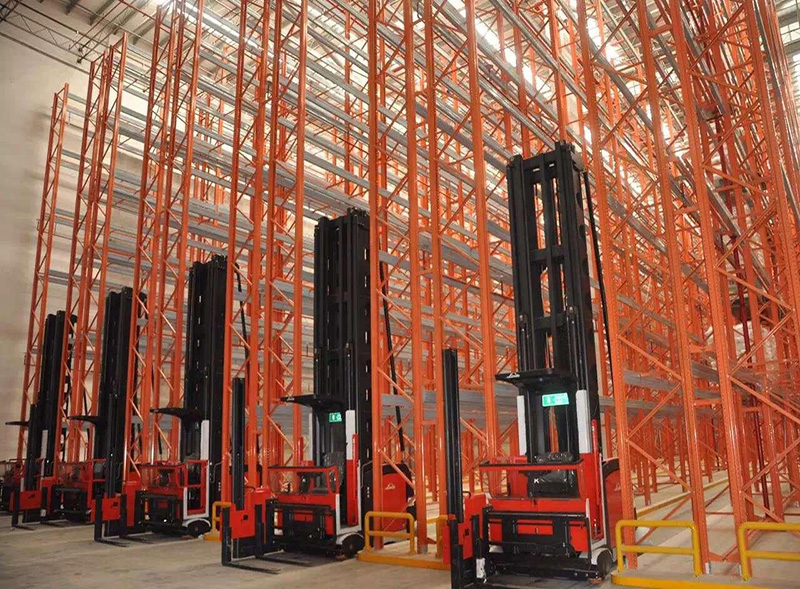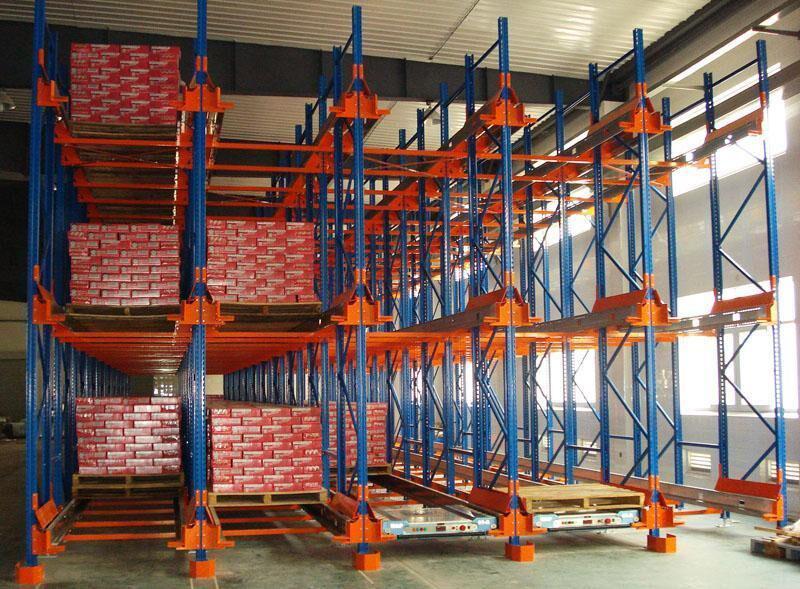In the relentless pursuit of warehouse efficiency and cost reduction, maximizing the utilization of existing cubic space is paramount. Traditional wide-aisle racking systems, while simple, often leave significant vertical and horizontal space underutilized. Enter Narrow Aisle Pallet Racking – a sophisticated storage solution designed to dramatically increase storage density without expanding the warehouse footprint. This comprehensive guide explores the key aspects of this powerful system.

What is Narrow Aisle Pallet Racking?
Narrow Aisle Pallet Racking (NA Racking) is a high-density storage system characterized by significantly reduced aisle widths compared to conventional selective pallet racking. While traditional systems require aisles of 11-13 feet (3.3-4 meters) to accommodate standard counterbalance forklifts, narrow aisle racking typically operates within aisles ranging from 6 to 8.5 feet (1.8 to 2.6 meters). This drastic reduction in aisle space directly translates to more available space for storage lanes.
The core principle is simple: narrower aisles allow for more rows of racking within the same warehouse floor area. However, achieving this safely and efficiently requires specialized equipment and careful design. Unlike standard racking accessed by wide-turning forklifts, narrow aisle pallet racking necessitates the use of specialized narrow aisle forklifts (also known as turret trucks, swing-reach trucks, or bi-directional trucks) equipped with features like articulating masts, specialized guidance systems, and operator cabins that elevate with the load.
Key Benefits of Implementing Narrow Aisle Pallet Racking
The primary driver for adopting narrow aisle pallet racking is its remarkable ability to enhance storage capacity:
1.Significantly Increased Storage Density: This is the standout advantage. By reducing aisle widths by 30-50%, warehouses can often increase their pallet positions by 20-50% or more within the same building envelope. This directly delays or eliminates the need for costly expansion or relocation.
2.Improved Space Utilization: Narrow aisle racking makes much better use of the building's cube, especially its vertical space. Combined with taller racking structures (often requiring high-reach NA trucks), it maximizes storage upwards.
3.Enhanced Operational Efficiency: While travel speeds in narrower aisles might be slightly reduced, the drastic reduction in travel distance between pick locations often leads to net gains in productivity. Operators spend less time traversing wide aisles and more time loading/unloading.
4.Potential Labor Cost Savings: The increased density and efficiency can sometimes allow the same workload to be handled with fewer forklifts and operators, leading to labor cost savings.
5.Reduced Building Costs (for new facilities): For new warehouse construction, specifying narrow aisle pallet racking can lead to a smaller building footprint for the same required storage capacity, resulting in lower construction costs, reduced roofing, lighting, and HVAC requirements.

Essential Equipment: The Narrow Aisle Forklift
The success of a narrow aisle pallet racking system is intrinsically linked to the specialized material handling equipment required to operate within it. Standard forklifts simply cannot maneuver safely or effectively in these confined spaces. Key types include:
•Turret Trucks: Feature a rotating turret that allows the forks to turn sideways (90 degrees) within the aisle while the truck body remains stationary and parallel to the aisle. The operator cabin elevates with the load for precise placement at height. Ideal for very narrow aisles (VNA - down to ~5.5 ft / 1.67m).
•Swing-Reach Trucks: Similar to turret trucks but the entire mast rotates (swings) to position the forks sideways. They typically operate in slightly wider aisles than pure turret trucks but offer excellent reach capabilities. Operator usually elevates with the load.
•Bi-Directional Trucks: Operate like a combination of a reach truck and a counterbalance truck. They can travel long distances in the narrow aisles and then turn 90 degrees to enter the racking bay. Operator may or may not elevate.
•Guided Systems: Many narrow aisle forklifts utilize guidance systems (wire, optical, magnetic tape, or laser) to ensure precise travel down the center of the aisle, minimizing the risk of rack strikes and allowing for even narrower aisles and higher speeds safely. This is crucial for maximizing the potential of narrow aisle pallet racking.
These trucks require skilled operators trained specifically for NA operations, emphasizing safety, precision, and awareness in confined spaces.
Critical Design Considerations for Narrow Aisle Systems
Implementing narrow aisle pallet racking is not simply about squeezing racks closer together. It demands meticulous planning and engineering:
1.Aisle Width Determination: This is fundamental. The exact aisle width depends on the specific narrow aisle forklift model chosen (including its turning radius and mast type), the pallet size, the required clearances (typically 3-6 inches / 75-150mm per side), and the rack upright depth. Precise calculations are non-negotiable.
2.Rack Configuration & Specifications: Narrow aisle racking often uses standard upright frames and beams, but the loading and configuration must be carefully engineered for the specific application, especially considering potential seismic loads and the increased height common in NA systems. Upright protectors are highly recommended. Load beams must be rated for the specific NA truck impact forces.
3.Building Constraints: Floor flatness is critical for safe NA truck operation and guidance system accuracy. Overhead clearances must accommodate the tallest racking and the elevated truck mast. Column spacing within the building must align with the racking layout. Lighting, sprinkler systems, and HVAC must be designed considering the dense racking layout.
4.Pallet Characteristics: Consistency in pallet size, quality, and load stability is paramount. Warped or damaged pallets significantly increase the risk of accidents in tight aisles.
5.Safety Systems: Beyond operator training, consider enhanced rack protection (guard rails, column protectors), clear signage, defined pedestrian exclusion zones, and potentially sophisticated collision avoidance systems (CAS) integrated with the forklifts and warehouse management system (WMS).
Implementation Process: From Planning to Operation
Successfully deploying narrow aisle pallet racking requires a structured approach:
1.Comprehensive Needs Assessment: Analyze current and future storage volumes, SKU profiles, turnover rates (ABC analysis), pallet specifications, and operational workflows. Define clear goals (e.g., 30% more pallet positions).
2.Conceptual Design & Feasibility: Develop initial layouts considering building dimensions, potential aisle widths, and equipment types. Conduct a feasibility study including ROI analysis comparing NA to alternatives.
3.Detailed Engineering & Specification: Finalize the racking design (layouts, load calculations, anchorage), select the specific narrow aisle forklift models, and define guidance system requirements. Ensure all components meet relevant safety standards (RMI, OSHA, ANSI).
4.Site Preparation: Ensure the floor meets flatness tolerances. Mark out aisles precisely. Address any necessary building modifications (lighting, sprinklers, column reinforcements).
5.Installation: Experienced installers are crucial for the precise and safe erection of the narrow aisle pallet racking structure, ensuring plumb alignment and secure anchoring.
6.Equipment Delivery & Commissioning: Deliver and install the NA forklifts and any guidance systems. Perform thorough commissioning and testing.
7.Operator Training & Certification: Implement rigorous, certified training programs focusing on safe operation in confined spaces, load handling at height, emergency procedures, and specific truck features. Refresher training is essential.
8.Operational Procedures & WMS Integration: Develop strict operating procedures for the NA area. Integrate the system with the Warehouse Management System (WMS) for optimized put-away and retrieval paths. Define clear safety protocols and pedestrian management strategies.
Comparing Narrow Aisle Racking to Other Storage Systems
Understanding where narrow aisle pallet racking fits within the spectrum of storage solutions is key:
• Selective Pallet Racking (Wide Aisle): NA offers significantly higher density (20-50%+) but requires specialized, more expensive forklifts and higher operator skill. Selective racking offers faster access to every pallet and lower equipment/operational complexity. NA wins on pure density in existing buildings.
• Drive-In/Drive-Thru Racking: Drive-in offers even higher density than NA but operates on LIFO or FIFO principles, reducing selectivity and increasing the risk of product damage and slower throughput. NA maintains full pallet selectivity.
• Push-Back Racking: Push-back offers good density with LIFO within a lane and better selectivity than drive-in. It can sometimes be integrated with NA trucks but often requires specialized reach trucks. Density per square foot is typically less than pure NA racking but offers dynamic storage benefits.
•Pallet Shuttle Systems: Shuttle systems (automated or semi-automated) offer very high density and throughput within deep lanes but require significant investment and are less flexible for varying SKUs. NA offers more flexibility and lower entry cost.
• Automated Storage and Retrieval Systems (AS/RS): AS/RS provides the highest density, speed, accuracy, and safety but comes with the highest capital cost and complexity. Narrow aisle pallet racking offers a highly efficient, high-density manual alternative.
Conclusion: Is Narrow Aisle Pallet Racking Right For You?
Narrow Aisle Pallet Racking presents a compelling solution for warehouses and distribution centers seeking to dramatically increase storage capacity within their existing footprint. Its ability to boost pallet positions by 20-50% or more makes it a strategic investment for businesses facing space constraints and rising real estate costs.
However, realizing the full benefits requires careful planning, significant investment in specialized equipment, rigorous operator training, and meticulous attention to safety and building requirements. The decision hinges on a thorough analysis of your specific operational needs, product profile, budget, and long-term growth plans.
For operations prioritizing high-density storage while maintaining good accessibility and selectivity for a diverse range of SKUs, narrow aisle pallet racking often emerges as the optimal balance between cost, density, and operational flexibility. By partnering with experienced racking suppliers, forklift vendors, and warehouse designers, businesses can successfully implement this powerful system to unlock significant warehouse capacity and drive long-term operational efficiency. The journey to maximizing your cube starts with understanding the potential of narrow aisle racking.







